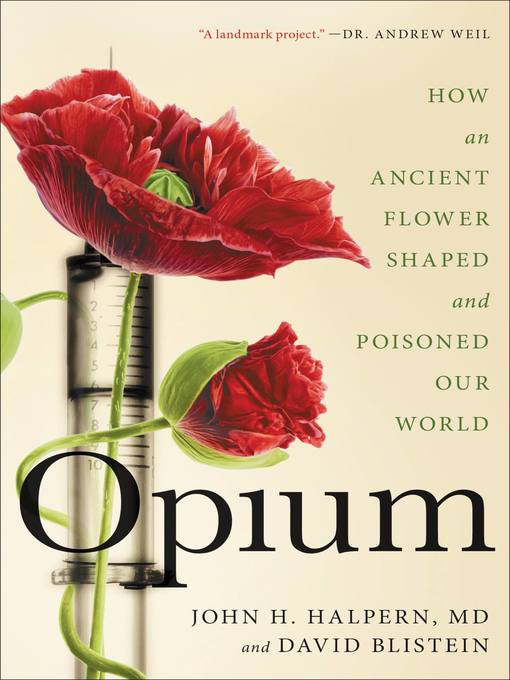
Opium
How an Ancient Flower Shaped and Poisoned Our World
کتاب های مرتبط
- اطلاعات
- نقد و بررسی
- دیدگاه کاربران
نقد و بررسی

June 24, 2019
Halpern, the Boston Center for Addiction Treatment’s former medical director, and Blistein (David’s Inferno), a PBS documentarian, study opium’s evolution (into morphine, heroin, oxycodone) and impact on world culture in an expansive but disappointing survey. To disprove any notion that “this crisis is worse, or fundamentally different, than any that has come before it,” the authors start in ancient Egypt, where opium was “part of an everyday health regimen,” and proceed to cover in rather repetitive fashion the first recorded drug crisis (in medieval Persia), the Silk Road between Asia and Europe, the Opium Wars between China and Great Britain, and today’s Silk Road drug marketplace on the dark web. The authors, having demonstrated the persistent failure of drug eradication to alleviate addiction, whether with Lin Ze Xu’s mass destruction of Canton’s opium in 1839 or Nixon’s war on drugs, end with their own suggestions, which include creating more needle exchanges and safe-injection sites and extending insurance coverage for addiction treatment. Their empathetic message is admirable, but the historical assertions are too often speculative—such as that Alexander the Great “undoubtedly” sought pain relief from war wounds with opium, which “likely” exacerbated his recklessness. Though well-intentioned, this study is unfortunately undermined by a weak narrative and a less than savvy use of history.

July 1, 2019
A breezy history of a substance that "is reluctant to give up its secrets" and a somber account of futile efforts to discourage its abuse. Psychiatrist Halpern and writer Blistein (David's Inferno: My Journey Through the Dark Wood of Depression, 2013, etc.) begin with the bad news. "In 2017," they write, "47,600 people died of opioid-related overdoses--more than gunshots and car crashes combined...and almost as many as were killed in the entire Vietnam War. The disease is straining our prison system, dividing families, and defying virtually every legislative solution to treat it." Rewinding the clock, the authors explain that no wild poppy produces as much opioid-rich sap as Papaver somniferum, so it was likely a mutation preserved by prehistoric humans. For millennia, physicians and writers praised its effects, and people consumed it as liberally as many of us take aspirin. Addiction was known and deplored, but opium was legal and cheap, so users usually led normal, productive lives. Many Americans regarded addiction as a moral failure, which was aggravated by the myth that opiate use was a foreign--mainly Chinese--depravity. America's first anti-drug law was an 1875 San Francisco ordinance making it a misdemeanor "to operate or visit an opium den." It didn't work, but activists persisted. In 1922, Congress first legislated severe penalties for possessing or selling illegal narcotics. This was also a failure, but it was not a national issue because addiction seemed confined to nonwhite races. Matters changed with the 1960s and an explosion of drug use among whites. The U.S. has spent more than $1 trillion fighting the Richard Nixon-initiated war on drugs. Ironically, the traditional opiate villain, heroin, is becoming scarce as superpowerful, synthetic narcotics--e.g., Fentanyl--are replacing natural opiates, leading to the current addiction epidemic. Straining for optimism, the authors describe scientific advances and a change in our moral disapproval of addiction, which might help alleviate this disaster. A fine account of opium and its misuse, which so far seems to be an insoluble problem.
COPYRIGHT(2019) Kirkus Reviews, ALL RIGHTS RESERVED.

June 28, 2019
More than 70,000 Americans die each year from opioid overdoses. How did we get here? Halpern (former faculty of Harvard Medical School) and Blistein (author of the PBS documentary The Mayo Clinic) provide readers with a comprehensive overview of the history of opium use. Opium, in various forms, has been used to relieve pain for thousands of years. In addition to explaining the many discoveries scientists and pharmacologists have made throughout history, the authors describe the role opium has played both culturally and politically throughout the globe. Opium use in antiquity, the 19th-century Opium Wars between Britain and China, America's entry into the opium trade, and Purdue Pharma's deceptive marketing of OxyContin are a few highlights. The final section reviews America's failed drug laws, inappropriately punitive criminal justice system, and failure to help those who suffer from addiction. The authors offer concrete ways to address the problems facing society, from criminal justice reform to effective pharmaceutical innovation. VERDICT Part history text and part cultural commentary, this is essentially a biography of opium. The story, however, is far from over; there is much work to be done in addressing the opioid crisis. In this informative, insightful, and ultimately hopeful work, the authors offer concrete solutions to an epic problem.--Ragan O'Malley, Saint Ann's School, Brooklyn
Copyright 2019 Library Journal, LLC Used with permission.

July 1, 2019
Before exploring humans' fraught relationship with opium, Halpern, a psychiatrist who specializes in the treatment of substance-use disorders, engages readers by sharing the story of a friend who committed suicide due to prolonged opioid use, and an alarming statistic: in 2017 alone, 47,600 Americans died from �opioid-related overdoses?almost as many as were killed in the entire Vietnam War. Subsequent chapters document opium usage over the last 8,000 years or so, reconsidering historic events in fresh contexts: the Spice Road was primarily used for drug trafficking; the discovery of the New World popularized the second most addictive substance in the world, tobacco; and the nineteenth-century Opium Wars were mere warm-ups for twentieth-�century pharmaceutical competition and greed. Halpern identifies misunderstandings about opioid addiction that fuel well-intentioned but ultimately futile social and government interventions, especially in our era of the Dark Web, Mexican drug cartels, and medical breakthroughs like OxyContin. Authoritative, engaging, and accessible, this call for action offers solutions?insurance and criminal justice reforms, alternative treatments, and eradication of punishment?and avenues to greater overall understanding.(Reprinted with permission of Booklist, copyright 2019, American Library Association.)

























دیدگاه کاربران